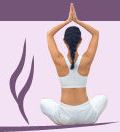Ayurveda and Drug Free Living
Wisdom is to the mind what health is to the body.
Modern physiology is known through dissection, but the ancient physiology was known through meditation by the Sages. Ayurveda is one such ancient and divine Indian system of natural and holistic medicine.
A patient being treated with Ayurveda is considered as a total combination of body, mind, senses and soul. The Ayurvedic doctor aims to achieve complete health for the patient, not just to suppress the troubling physical symptoms. The approach is to diagnose the root cause and eliminate the same to facilitate a natural and genuine healing.
Ayurveda is not simply a healthcare system, but a form of lifestyle adopted to maintain perfect balance and harmony within the human existence.
History of Ayurveda
Ayurveda, which translates to 'knowledge of life', dates back 5000 years to the ancient Samskrita (Sanskrit) texts, the Vedhas - the divine books of knowledge propounded by spiritual Rishis (Sages) in India.

A Rishi
In the earlier days of its conception, the system of Ayurveda was orally transferred through the Gurukul system until written scripts came into existence. The significant scripts on Ayurveda are Charaka Samhita, Sushruta Samhita and Ashtanga Hridaya.
Around 1500 BC Ayurveda was delineated into to two distinct schools: Athreya - the school of Physicians, and Dhanvanthari - the school of Surgeons. This made Ayurveda a more systematically classified medical science. Hereafter Dhanvanthari, who is considered to be a reincarnation of Lord Vishnu, was the guiding sage of Ayurveda. He made this science of health and longevity popular and widely acceptable.
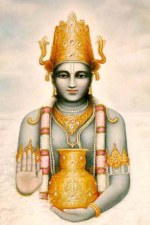
Lord Vishnu as Dhanvanthari
In fact the two schools of thought led to the writing of two major books on Ayurveda - Charaka Samhita and Sushruta Samhita. These two Samhitas were written in the early part of 1000 BC. The great sage - physician Charaka authored Charaka Samhita revising and supplementing the text written by Athreya. And it has remained the most referred Ayurvedic text on internal medicine till date.
Sushruta, following the Dhanvanthari school of thought, wrote Sushruta Samhita, comprising the knowledge about prosthetic surgery to replace limbs, cosmetic surgery, caesarian operations and even brain surgery. He is famed for his innovation of cosmetic surgery on nose or Rhinoplasty.
Around 500 AD Vagbhata compiled the third major treatise on Ayurveda, Ashtanga Hridaya, which is a concise version of the works of Charaka and Sushruta. It contained the knowledge of both the schools of Ayurveda.
From 500 AD to 1900 AD, 16 major Nighantus or supplementary texts on Ayurveda were written incorporating new drugs, expansion in applications, discarding old drugs and identification of substitutes.
Meanwhile the texts on Ayurveda were translated into many languages and a growing number of people are practising this system of medicine throughout the world. There are few distinguished institutions which offer authentic Ayurvedic treatments. One among them is Kottakkal Arya Vaidya Sala in Kerala - India, founded by Vaidyaratnam Sri P. S. Varier.
Principles of Ayurveda
1) Each person is a Microcosm in the Macrocosm - the Universe.
2) Universe is made up of the combinations of five elements (Panchamahaabhutas) - Earth, Water, Fire, Air and Ether (Space). In the same fashion each person is unique and is made up of these five elements in different proportions.
3) Five elements are categorized into three biological forces or Doshas which govern all life processes.
4) The three Doshas are: Vaata, Pitta and Kapha
5) Each person is influenced by certain elements more than by other elements. This is because of their natural constitution.
- If a person is influenced by Air and Ether elements then he/she is categorized as a person with Vaata Dosha.
- If a person is influenced by Fire element then he/she is categorized as a person with Pitta Dosha.
- If a person is influenced by Earth and Water elements then he/she is categorized as a person with Kapha Dosha.
6) Most people's constitution is made up of a combination of two Doshas. For instance, people who are 'Vaata Pitta' type will have the characteristics of both Vaata Dosha and Pitta Dosha, with Vaata dominating.
7) The three Doshas regulate all the physiological and psychological processes in a living organism. The interplay among these three forces determines the qualities and conditions of an individual. A harmonious state of the three Doshas creates balance and health. An imbalance, which might be an excess or deficiency, manifests as a symptom of disease.
8) To keep the Doshas in balance, the first step is, one has to find out which Dosha or combination of them is dominant in one's body. Preferably this would be determined by an experienced practitioner of Ayurveda. The diagnostic process also determines which Doshas are underactive or overactive in the body. According to that the Ayurveda practitioner chooses the right treatment procedure.
Treatment methods
Ayurveda offers mainly three kinds of treatments:
1) Panchakarma and special treatments
2) Ayurvedic medicines
3) Diet and lifestyle control
Panchakarma comprises of a number of Ayurvedic therapies involving detoxification, therapeutic cleansing of the body and rejuvenation as a treatment for many chronic conditions. Panchakarma includes Vamana, Virechana, Basti, Nasya and Raktamokshana.
Some of the special treatments are Abhyanga, Sirodhara, Shirovasti, Pizhichil, Navarakkizhi, etc.
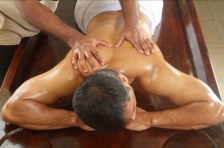
Abhyanga - General body massage
Ayurvedic medicines mainly comprise of powders, tablets, decoctions, medicated oils, etc, which are prepared from natural herbs, plants and minerals.
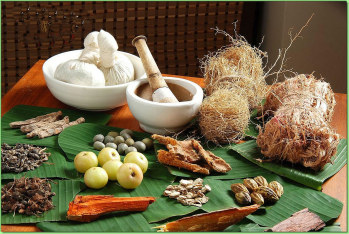
Few ingredients of Ayurvedic Medicine
Osho's view on Ayurveda
In Ayurveda, which evolved by the side of Yoga in the ancient India, a physician had to be a yogi also. Unless you are a Yogi you cannot be a real physician. You cannot be a real healer. The physician had to watch his own inner arrangement before he would go to the patient to see and treat him.
The word for medical science in the East is Ayurveda. Even the word will show you the difference. In the West you call it 'medicine'. Medicine means curing, healing, but can you see the implication? It does not mean health, it comes after the disease has already come in. It is a follow-up. First you are sick, then comes the doctor. The doctor follows sickness, with his bag of medicines.
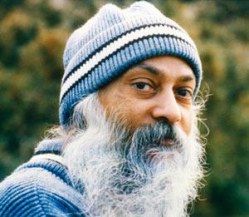
Osho
Ayurveda means the science of life. The very word has nothing to do with disease, sickness; it has something to do with life, health, longevity. It is positive, it is not negative. It shows you the way to remain healthy, to remain young as long as you want, to live longer if that's what you want. Its focus is not on sickness, its focus is on health.
Patanjali's Yoga system and Hindu system of medicine, Ayurveda, developed simultaneously, together. Ayurveda is totally different than Allopathy. Allopathy is suppressive of the disease. If you are ill, allopathy immediately suppresses the illness. Then the illness tries some other weak point to come up. Then from somewhere else it explodes. Then you suppress it from there, then from somewhere else it explodes. But with allopathy, you go on from one illness to another, from another to another, but it is a never-ending process.
Ayurveda has a totally different concept. Illness should not be suppressed: it should be released. A catharsis is needed. So Ayurvedic medicine is given to the ill person so that the illness comes up and is thrown out, a catharsis. So the beginning doses of Ayurvedic medicine may make you more ill, and it takes a long time because it is not a suppression. It cannot be done right now: it is a long process. The illness has to be thrown, and your inner energy has to become a harmony so the health comes from within. The medicine will throw the illness out, and the healing force will replace it from your own being.
From Ayurveda and Drug Free Living to Drug Free Living Home
Like This Page?
